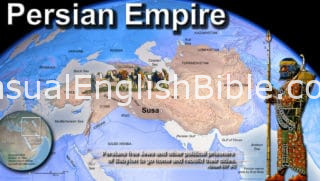Jews rebuilt their own destroyed houses before they rebuilt God’s house—the Jerusalem Temple.
God didn’t like that one bit.
He had the prophet Haggai tell ‘em so.
“You say it’s not yet time to rebuild the LORD’s house from the ruins. But I’ve noticed it is time for you to live in nicely appointed houses paneled in wood” (Haggai 1:4).
That’s called a divine zinger, one of many in the Holy Bible.
Jews ordered to stop building in Jerusalem
Jews apparently felt they had good reason not to rebuild the temple. They had started the work as soon as they got back from exile in Iraq. That’s where Babylonians forced them to stay for 66 years. Persians from what is now Iran defeated Babylon and told the Jews they could go home.
Settlers who had moved into the region objected. They didn’t want Jews dragging their dead nation up out of the dirt. So, they threatened them. Later, they convinced a new Persian king to stop all building projects in Jerusalem.
Eighteen years afterward, Haggai shows up, but for just four sermons—one a month.
How to get good crops through carpentry
On August 29, 520 BC, at the end of what sounds like a terrible year for farmers, Haggai tells them how to fix it.
He says God broke it.
And God will fix it.
But only if they get back to work on the Temple.
“I’m the LORD and I did it. I hit you with heat, mold, and hail. But you didn’t get the message. You didn’t come back to me” (2:17).
Jews rushed back to work on the Temple before the month is up: September 21.
Jews get the blues rebuilding the Temple
But they apparently get bummed out by December. Perhaps it’s because the Temple isn’t shaping up as magnificent of Solomon’s Temple.
Haggai apparently pumps them with a reminder about a good harvest ahead—and with the promise that this Temple will be bigger and better than Solomon’s.
The Little Temple that wasn’t big
As it turns out, it wasn’t. Jews finished building Zerubbabel’s Temple on March 12, 515 BC, some four and a half years after they started the work. Solomon mobilized the nation’s top artisans and drafted citizens who spent seven years working on that Temple.
Haggai’s promise for the bigger Temple had to wait another 500 years. That’s when King Herod the Great started expanding the Temple into what some scholars call the Third Temple. But it’s better known as Herod’s Temple. The expansion project continued for 80 years, until AD 64.
It lasted six years. Jews revolted against their roman occupiers in AD 66. They lost the war and lost Jerusalem—Romans leveled it. Throughout known history, only the Babylonians of what is now Iraq and the Romans of Italy have leveled Jerusalem.
Jewish Temple: Never rebuilt
The Temple hasn’t been rebuilt.
That’s because Jerusalem’s most visible landmark sits about where the Temple once did. The iconic building is a 1400-year-old Muslim shrine called the Dome of the Rock. A huge rock inside is tied to various legends such as: Abraham almost sacrificed Isaac there; Muhammad ascended to heaven from there, escorted by the angel Gabriel.
Writer
If Haggai didn’t write these 38 verses presented as two chapters, at least he spoke them. Scholars say his words were likely preserved soon after he spoke.
A low-profile prophet, Haggai shows up for only four months in his own book and twice outside his book: Ezra 5:1; 6:14. We know nothing about his age, where he came from, how long he had been in Jerusalem, or if he was old enough to remember Solomon’s Temple from 66 years earlier.
Timeline
Haggai preached four times between August and December in 520 BC:
- August 29
- September 21
- October 20
- December 18
Oddly, Haggai did what we wish all the Bible writers had done. He gave us timeline landmarks by identifying the year, month, and day in relation to when the current king took the throne, Persian ruler Darius the Great. Persian documents, such as the Cyrus Cylinder, along with timeline clues in other Bible prophecies help scholars, in a way, triangulate the location on the calendars.
 Location
Location
Jerusalem, or what’s left of it. Babylonian invaders tore down the walls, homes, and Temple 66 years earlier, and deported many of the surviving Jews. Persians freed Jews to go home in 539 BC, some 18 years before Haggai. They started rebuilding, but Persians made them stop after non-Jewish settlers in the area warned Persians about how rebellious the Jews have always been. A later king reversed the work stoppage order.
Purpose
Haggai says God wants the Jews of Jerusalem to rebuild the Temple: “Don’t be discouraged…. I am with you. So, get back to work” (Haggai 2:4).
Ezra and Nehemiah say the people were disappointed and afraid of rebuilding. That’s because non-Jews who moved into the Jewish homeland while the Jews were exiled to Iraq didn’t want them rebuilding their nation. And they talked a new Persian king into ordering Jews to stop rebuilding.
Haggai told them not to be afraid because God is with them—and he wants them to get back to work.


 Location
Location

